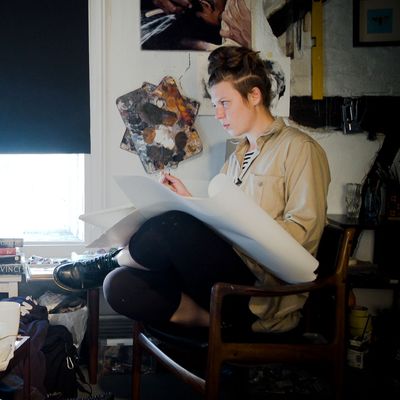
There’s an unacknowledged tension at the core of The Painter and the Thief, a deliciously absorbing documentary from Norwegian filmmaker Benjamin Ree (Magnus) — a tension that’s unignorable even as it’s buried by emotional pain and channeled into acts of creation and appreciation. The story begins with a crime in an Oslo gallery, where one of the film’s subjects steals a few works of art by the other subject of the film. But this isn’t a mystery, and the focus instead turns toward an exploration of how the dynamic between victim and perpetrator quickly shifts into that of artist and muse. The Painter and the Thief is an examination of the intersection between inspiration and self-destruction, and of a rapport so deep and instantaneous it feels like evidence of the existence of a soul. But alongside these elements is always the steady thrum of another question, one that sometimes grows so insistent it seems impossible that everyone onscreen can continue to just pretend it isn’t there: Are these people going to fuck or what?
I don’t mean to besmirch the spiritual connection between Barbora Kysilkova and Karl-Bertil Nordland with unwelcome carnality. But there is something remarkable about how neither of these fetchingly melancholic Europeans, nor their respective romantic partners, ever appear to acknowledge what seems like an obvious facet of the intense pull between them. “The moment I met him at the courtroom, I really sort of fell in love with him,” Kysilkova informs her boyfriend, Øystein. “There was no way I could see the thief in this guy. I just saw purely, like, a naked soul.” This attempt to transcend the carnal feels at first nigh-implausible, as Kysilkova starts sketching, then painting, then photographing Nordland in ways that are incontestably sensuous. As the film goes along, however, it starts to feel essential to the pair’s continuing coexistence. Kysilkova and Nordland are intent on sharing another sort of vulnerability — of seeing each other as unguardedly as possible, to the point in which more fleshly communions feel unnecessary.
Kysilkova is a Czech artist who came to Norway to start over, one whose style is naturalistic, even as her subject matter tends toward the morose. One of the paintings that was stolen by Nordland from that Oslo gallery, and that becomes a kind of bookend in Ree’s film, depicts a dead swan curled amid reeds like a precious keepsake cushioned in decorative wrapping. Nordland, rakish and battered and covered in ink, is a junkie who claims not to remember what he and his accomplice did with either the swan painting or the other work they took, having been on a four-day bender at the time. When Nordland tells Kysilkova he took the paintings because “they were beautiful,” you might assume he’s full of shit for so flatteringly framing what he did as an act of radical art appreciation. When Kysilkova asks Nordland to sit for a portrait as a way of making amends, you might assume she is full of shit, as well — or at least that she’s come up with a cunning way to finagle more information out of him. But as it turns out, they’re both on the level, these wounded creatures with matching mile-wide dark streaks. They fit together like puzzle pieces that have been dinged but not fatally damaged.
Ree unfolds this strange but true story using some techniques more often seen in scripted fare. Both of the subjects offer a rundown of some of the things they know about the other, accompanied by a whimsically quick montage illustrating each bullet point. Nordland has never traveled for pleasure, he hates pickles in burgers, he loves old wooden churches; Kysilkova has a circular tattoo on the back of her neck, she became fascinated with death at a young age, her last relationship was abusive. It’s the cinematic language of an indie romance, and that’s what this is, in a way, even if the love it’s about is not the expected sort. The film begins from Kysilkova’s point of view and then goes back in time in an attempt to take Nordland’s, a jump in perspective that’s derailed by a dramatic, unexpected incident that takes place at the center of the film. Even so, Ree revisits the scene in which the pair first meet, with the camera dwelling on Nordland’s gaze at the woman drawing him the second time, as he offers up his thoughts in the moment by way of voice-over. “She sees me very well, but she forgets that I can see her too,” he says of his unlikely friend.
And that is, maybe, the point of this strange, delicately made film, which manages to defy expectations about both of its subjects and the power balance between them. When Kysilkova shows Nordland the first painting she’s done of him, the astonishing sequence is one of the great movie moments of this condensed year. He’s left speechless, his eyes and mouth going cartoon-character round, so overwhelmed that he’s almost angry before the tears start. In the raw purity of his reaction, it’s possible to understand some of what the artist sees in him. What The Painter and the Thief does so well is show us how these two people are better, or at least more interesting, when glimpsed through each other’s eyes. The film is a portrait of an intimacy that’s as impressive as it is unsettling, and, as the perfect final image proves, it’s also a portrait of a portrait, put on display for anyone to see — or steal.


